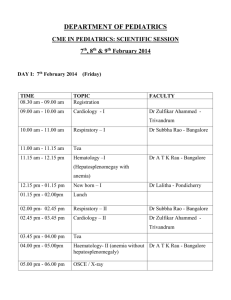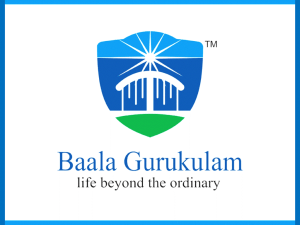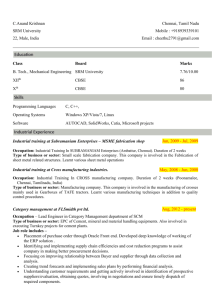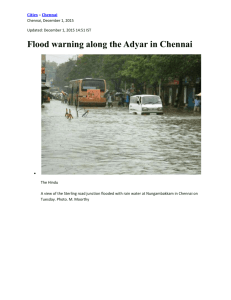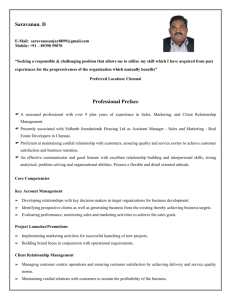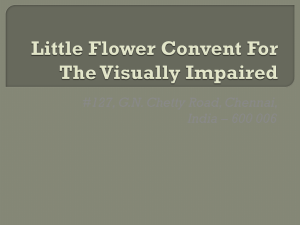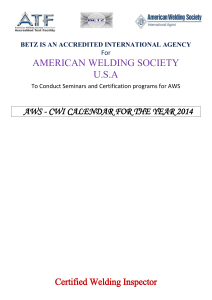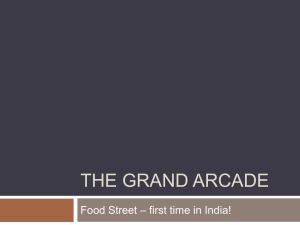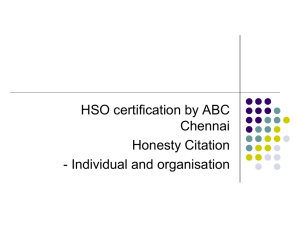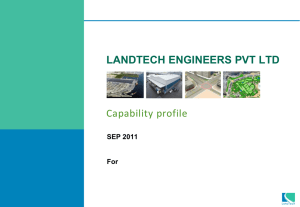TOP PLAGIARISM SCANDALS
advertisement
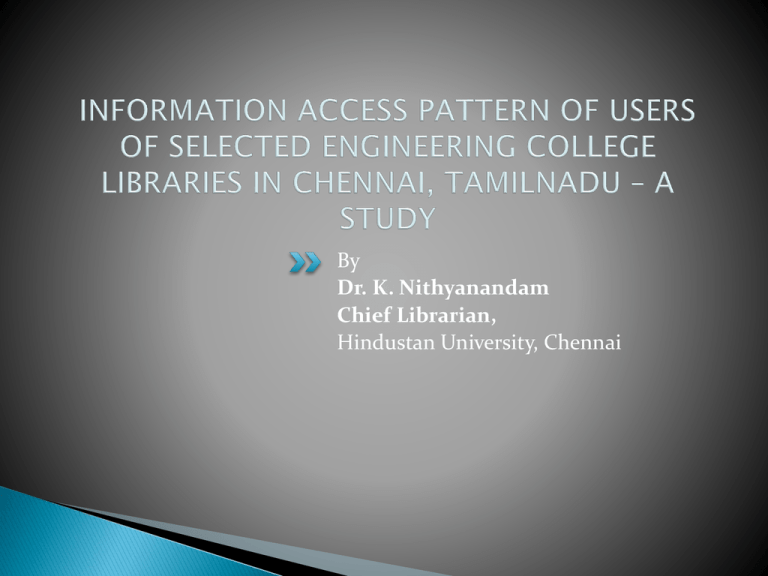
By Dr. K. Nithyanandam Chief Librarian, Hindustan University, Chennai Systematized and cumulative structure of scientific knowledge is shaped by the quick temperament of the researcher Scientific and technical data between countries or within a given country is essential Work place community needed much pinpointed information No significant studies on assessing information access pattern of Engineering College library users is found in the library science literature, Study is proposed to have depth analysis on the information seeking behaviors of a particular work place community like faculty and students of Engineering Colleges in Chennai City Structured questionnaire survey and observation. Data collected through the questionnaire was tabulated and statistical tests viz., Percentage Method, Chi-square and t-test were applied to test the hypotheses. S.No Name of the Engineering Colleges 1. Sriram Engineering College, Chennai. 2 Jeppiaar Engineering College, Chennai. 1. Jaya Engineering College, Chennai. 1. Sairam Engineering College, Chennai. 1. K.C.G Engineering College, Chennai. 1. Peri Institute of Technology, Chennai. 1. Meenakshi College of Engineering, Chennai. 1. R.M.K Engineering College, Chennai. 1. P.M.R Institute of Technology, Chennai. 1. Sri Venkateswara College of Engineering, Chennai The researcher has collected data only from the students and faculty who are available in the libraries of the selected institutions during the survey The researcher has chosen only ten engineering colleges in the city and not deemed universities. Use of electronic source of information Wikipedia Blogs Social networks Online Databases CD-ROM Databases Websites Portals Subject Gateways Students N=358 Assistant Professor N=76 Associate Professor N=68 Professor N=46 Total N=548 301 (84.08) 245 (68.44) 154 (43.02) 256 (71.51) 152 (42.46) 196 (54.75) 172 (48.04) 194 (54.19) 68 (89.47) 59 (77.63) 38 (50.00) 71 (93.42) 73 (96.05) 65 (85.53) 37 (48.68) 34 (44.74) 57 (83.82) 53 (77.94) 36 (52.94) 57 (83.82) 64 (94.12) 38 (55.88) 26 (38.24) 14 (20.59) 22 (47.83) 12 (26.09) 14 (30.43) 24 (52.17) 35 (76.09) 21 (45.65) 15 (32.61) 12 (26.09) 448 (81.75) 369 (67.34) 242 (44.16) 408 (74.45) 324 (59.12) 320 (58.39) 250 (45.62) 254 (46.35) Students N=358 Assistant Professor N=76 Associate Professor N=68 Professor N=46 Total N=548 Factual and Statistical Information Information for writing research articles 170 (47.49) 195 (54.47) 279 (77.93) 298 (83.24) 51 (67.11) 68 (89.47) 63 (82.89) 71 (93.42) 51 (75.00) 62 (91.18) 60 (88.24) 60 (88.24) 29 (63.04) 35 (76.09) 31 (67.39) 41 (89.13) 301 (54.93) 360 (65.69) 433 (79.01) 470 (85.77) Information for preparing project proposals 176 (49.16) 69 (90.79) 61 (89.71) 42 (91.30) 348 (63.50) 109 (30.45) 82 (22.91) 99 (27.65) 41 (53.95) 70 (92.11) 49 (64.47) 38 (55.88) 58 (85.29) 56 (82.35) 40 (86.96) 41 (89.13) 44 (95.65) 228 (41.61) 251 (45.80) 248 (45.26) Type of Information often required Procedural Information Product Information For administrative progress For guiding the Students For special lectures and Academic activities S.No Information Searched 1. E-books 1. Full text articles 1. Articles abstracts 1. Standards 1. Patents 1. Formulas 1. Models/designs Rank 1 Rank 2 Rank 3 Rank 4 Rank 5 Total 442 80 26 00 00 548 426 98 20 4 00 548 411 87 32 10 8 548 121 129 140 115 43 548 64 51 114 98 221 548 21 57 135 101 234 548 324 76 115 30 3 548 S.No Particular No. of Respondent s Percentag e 1. A general purpose search engine (e.g. Google, Yahoo) 369 67.33 1. A specific journals website 417 76.09 1. A multi-journals search website with links to full text (e.g. IEEE, ASCE, DEL, Science Direct and Springer Verlag) 417 76.09 Online citation index (e.g. Web of science, Scifinder, Scopus, BIOSIS) where only abstracts are available 361 65.88 Local libraries reference room or stacks 115 20.99 1. 1. S. No Bibliographic Database No. of Respondents Percentage 1. Scifinder 117 21.35 1. Scopus 120 21.90 1. Engineering Village 115 20.99 1. Web of Science 260 47.45 1. Dissertation Abstracts 150 27.37 1. LISA 15 2.74 1. Biological Abstracts 75 13.69 Open Access Resources PubMed Open JGate Public Library of Science Google Scholar OAISter Regularly Occasionall y Not at all Regularly Occasionall y Not at all Regularly Occasionall y Not at all Regularly Occasionall y Not at all Regularly Occasionall y Not at all 121 22 Associat e Professo r N=68 33 81 25 16 14 136 156 85 29 36 19 12 13 09 217 142 126 21 35 14 196 147 49 19 00 21 00 23 00 210 49 100 38 26 39 203 209 79 38 36 42 32 07 31 296 178 112 14 22 12 160 167 49 26 01 14 00 03 00 210 50 112 56 20 12 200 197 19 48 34 298 Assistant Students Professo r N=358 N=76 % Professo r N=46 Total N=548 19 195 35.58 24.82 39.60 25.91 35.77 38.32 8.94 37.04 54.01 32.48 29.20 38.32 9.12 36.50 54.38 S.No Search Options No. of Respondents Percentage 276 50.36 1. By Titles 1. By Subjects 75 13.69 1. By Authors 115 20.99 1. By Keywords 320 58.39 1. By Publishers 61 11.13 1. By Date of Issue 251 45.80 1. By Journal Name 325 59.31 1. By Year/Period 69 12.59 Students N=358 Assistant Professor N=76 Associate Professor N=68 Professor N=46 Total N=548 Education 214 (59.78) 65 (85.53) 54 (79.41) 40 (86.96) 373 (68.07) Research 102 (28.49) 72 (94.74) 61 (89.71) 43 (93.48) 278 (50.73) Communication 185 (51.68) 35 (46.05) 29 (42.65) 24 (52.17) 273 (49.82) Entertainment 259 (72.35) 19 (25.00) 16 (23.53) 11 (23.91) 305 (55.66) Business 56 (15.64) 22 (28.95) 13 (19.12) 09 (19.57) 100 (18.25) Household Activities 39 (10.89) 18 (23.68) 14 (20.59) 11 (23.91) 82 (14.96) Purpose of Using Internet S.No Details Number Percentage Deviation 1. Lack of knowledge in computer handling 273 49.82 -28.86 1. Lack of knowledge in browsing ejournals 294 53.65 -7.86 1. Limitation of internet access speed 305 55.66 3.14 1. Limitation of online full-text journal articles 323 58.94 21.14 1. Unfriendly library staff 292 53.28 -9.86 1. Lack of power supply 327 59.67 25.14 1. Untraceable of document 299 54.56 -2.86 Mean = 301.86 S.D. = 17.27 Information access pattern of the respondents studied is encouraging as the students and faculty are adopting the range of search methods and approaches to information. Accessing information through library staff is the most preferred mechanism used by the respondents to get information. The respondents also access information by trial and error. Training at work place and by participating workshops and seminars. Respondents prefer search documents by the title, keywords and by the journal name. Search through the author, publisher were preferred by less number of respondents. Among e-resources, e-books, full text articles, abstracts, models and designs were mostly used form of documents. Study could find the limitations pursued by the users in Chennai based selected Engineering College towards information access such as lack of knowledge in computer handling browsing ejournals, limitations of internet access speed, the attitude of library staff and power fluctuations.
